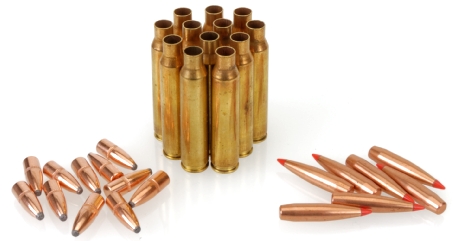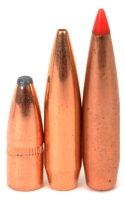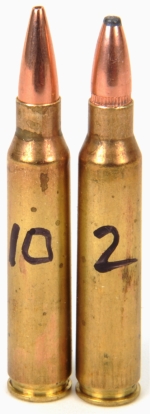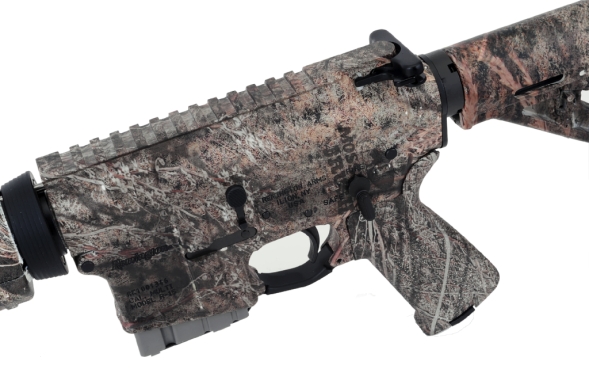 Time spent shooting the short barrel VTR was enlightening. Dropping down from a 24″ barrel standard to the 16″ barrel carbine reduced Remington Express 55 grain factory ammo from 3,240 fps to 2,939 fps, or 9%, 301 fps less.
Time spent shooting the short barrel VTR was enlightening. Dropping down from a 24″ barrel standard to the 16″ barrel carbine reduced Remington Express 55 grain factory ammo from 3,240 fps to 2,939 fps, or 9%, 301 fps less.
|
3,240 |
||||||
|
Range |
0 |
100 |
200 |
300 |
400 |
500 |
|
|
3240 |
2758 |
2322 |
1930 |
1583 |
1299 |
|
Energy |
1282 |
928 |
658 |
455 |
306 |
206 |
|
|
0.79 |
0.67 |
0.57 |
0.47 |
0.39 |
0.32 |
|
Path – |
-1.5 |
2.5 |
2.0 |
-5.1 |
-21.7 |
-52.3 |
|
2,939 |
||||||
|
Range |
0 |
100 |
200 |
300 |
400 |
500 |
|
|
2939 |
2486 |
2077 |
1712 |
1401 |
1167 |
|
Energy |
1055 |
754 |
527 |
358 |
240 |
166 |
|
|
0.72 |
0.60 |
0.51 |
0.42 |
0.34 |
0.28 |
|
Path – |
-1.5 |
2.7 |
1.3 |
-8.4 |
-30.0 |
-69.6 |
The tables cover 500 yards, however, anything beyond 300 yards is pretty much irrelevant for any application that dictates a compact, lightweight carbine. Inside 300 yards, the differences in hold over and terminal energy are negligible. Whatever could be effectively dispatched with the longer barrel gun could also be dispatched with the carbine.
There is another byproduct of a short barrel, increased muzzle pressure. With an increase in muzzle pressure, 11,000 psi compared to 6,000 psi, comes an increase in muzzle blast. The little Predator Carbine has a lot to say. Not objectionable, but certainly enough to prevent dozing at range sessions.
Scope mounting is easy. A set of high Warne rings secured directly to the rifle’s top rail put the Burris Fullfield’s optical centerline, eyeball centerline, with a proper hold. Sight systems could have been any type that would mount to a rail from reflex to folding metallic. For my purposes, a FastFire III was a good fit.
All of the R-15’s controls operated cleanly, crisply, positively as appropriate. Mags drop free cleanly and snap in positively. The charging handle pull is smooth… none of the typical gritty movement. The buttstock extends quietly, lock up is solid in interim positions or full in or out. Recoil is none existent. Empties are deposited on the ground a few feet from the port, making recovery easy, even in the snow.
All and all, the VTR proved to be a very accurate fire arm and highly reliable. It was also very accommodating when it came to handloads and ammunition types.
Yeah… this didn’t work

Two bullets were initially loaded for the Remington’s Model R-15™ VTR Predator Carbine, Remington 55 grain PSP which is usually sold in bulk and Hornady’s 75 grain A-Max… which is not. I use the latter bullet in fast twist, long throat, 22-250 Rem bolt action Model 700’s we put together in the shop and it produces exceptionally accurate results. Unfortunately, the very long ogive ahead of the bullet’s parallel shank requires exceeding COL significantly. The only two cartridges listed by Hornady that can utilize the bullet without exceeding COL are the 223 WSSM and the 22-6mm.
 Hornady does list the 75 grain A-Max within its 223 Remington Service Rifle data with a COL of 2.390″. This is approximately 0.070″ over maximum COL spec and the assembled rounds cannot be magazine fed. For this specialty application, service rifle 600+ yard competition, rounds are single shot fed. Chances of you or I assembling this combination for routine use are slim to none, so I thought we’d get this project back on the pavement and go with two commonly useful bullets.
Hornady does list the 75 grain A-Max within its 223 Remington Service Rifle data with a COL of 2.390″. This is approximately 0.070″ over maximum COL spec and the assembled rounds cannot be magazine fed. For this specialty application, service rifle 600+ yard competition, rounds are single shot fed. Chances of you or I assembling this combination for routine use are slim to none, so I thought we’d get this project back on the pavement and go with two commonly useful bullets.
In any event, L-R, the 55 grain seats to its cannelure and the 68 gain seats just aft of the ogive on the parallel surfaces of the bullet’s shank. The 75 grain, if seated to a COL that met 223 Remington specification, places the bullet’s ogive inside the case mouth.
 Shooting from a bench over extended distances to light up a chronograph have caused me to be fond of long barrel rifles, at least 24″ and 26″ barrels. However, my personal hunting and self defense firearms, with few exceptions, have barrel lengths on the short side. Rifle barrels fall into the 18″ to 22″ range, handguns in the 3.5″ to 4.5″ range. Subsequently, a great deal of time is spent working up handloads that are optimal for short barrels. Many don’t follow the rule of thumb that moderate to fast burn rate powders yield higher short barrel velocity because less powder is spewed, unburned, out of the end of a barrel.
Shooting from a bench over extended distances to light up a chronograph have caused me to be fond of long barrel rifles, at least 24″ and 26″ barrels. However, my personal hunting and self defense firearms, with few exceptions, have barrel lengths on the short side. Rifle barrels fall into the 18″ to 22″ range, handguns in the 3.5″ to 4.5″ range. Subsequently, a great deal of time is spent working up handloads that are optimal for short barrels. Many don’t follow the rule of thumb that moderate to fast burn rate powders yield higher short barrel velocity because less powder is spewed, unburned, out of the end of a barrel.
Principles can be uncertain…
After all of the calculation and theorizing, sometimes the truth is no farther away than the chronograph, a couple of rifles and a less than a lot of ammo. Six types of powder that are typical for use for the 223 Remington were selected based on progressive burn rates, handloads were assembled and then fired from both the 16″ Model R-15™ VTR Predator Carbine and my 20″ AR Frankenstein. In this case Frankenstein means only made from parts but, this time, with a more attractive result.
There actually isn’t a good correlation between burn rate, highest velocity and barrel length. There is some proportional correlation between powder types and short barrel / long barrel velocity differences, although the smallest difference doesn’t track to the highest velocity for each bullet length, nor do they follow powder burn rates. What doesn’t this all mean? Beats me, but I guess that means there is no rule of thumb and experimentation is required.
 |
Warning: Bullet selections are specific, and loads are not valid with substitutions of different bullets of the same weight. Variations in bullet length will alter net case capacity, pressure and velocity. Primer selection is specific and primer types are not interchangeable. These are maximum loads in my firearms and may easily be excessive in others. All loads should be reduced by 2%, and developed following safe handloading practices as represented in established reloading manuals produced by component manufacturers. Presentation of these loads does not constitute a solicitation for their use, nor a recommendation.
|
||||||||||||||||||||||||||||||||||||||||||||||||||||||||||||||||||||||||||||||||||||||||||||||||||||||||||||||||||||||||||||||||||||||||||||||||||||||
|
|||||||||||||||||||||||||||||||||||||||||||||||||||||||||||||||||||||||||||||||||||||||||||||||||||||||||||||||||||||||||||||||||||||||||||||||||||||||
So what about this Remington’s Model R-15™ VTR Predator Carbine?
I apologize if it seems we sort of ran off the road, into the weeds and then down into a ditch with this Part II. I just never feel like a proper assessment of a firearm is done unless handloads are part of the process. The VTR put together 3 shot, sub 1″, 100 yard groups routinely. The only powders that posed a bit of an accuracy issue were Hodgdon 4198 and Winchester 748, but even they were well inside of 1 1/2″. If I were going to carry and shoot this rifle routinely, I would probably settle on TAC as a primary powder and the heavier 68 grain Hornady bullet.

Concluding, I think we go back where we began. For situations where a lightweight, compact rifle fits the application, this R-15 is a very good fit. As the modern equivalent of a truck rifle, it offers solid utility and can take care of most situations and it will sling out of the way when not in use. The R-15 is well made and will last a long time with routine cleaning and maintenance. It is easy to take down and then reassemble and all of the popular aftermarket accessories. Price wise, it isn’t cheap, but then what worth owning is these days. A nice AR.
Remington’s Model R-15™ VTR Predator Carbine Part I
Remington’s Model R-15™ VTR Predator Carbine Part 2

Email Notification